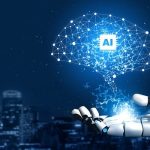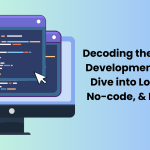Unless you are living under a rock, you must be aware of the quick integration of AI (Artificial Intelligence) in our lives. AI has emerged as a game-changer, fundamentally transforming the way we conceptualize, create and deliver digital experiences. The rapidly evolving landscape with the influence of AI gives us a different perspective about the future of various aspects. This includes UI UX design services too.
Many UX designers are skeptical about the potential impact of AI tools on UI, yet the opportunities are unstoppable. But now you might be worried that AI might take up your job soon. Yea or Nay! 
Let me state it outright: AI can assist UI/UX designers by automating certain aspects of their job, but cannot completely replace a human. AI has revolutionized the design process by automating repetitive tasks, analyzing user data to drive decision-making, and even predicting user behavior. It has introduced new possibilities for natural language interaction, advanced user research and testing methodologies. As AI continues to reshape the UI/UX, it is crucial for designers to understand its potential, integrate machine capabilities with a human-centered approach to enhance user experiences.
Now the questions arise, how can we make AI assist us? Or what are the key areas UI UX designers can take benefit from? That’s where we jump in!
In this article, we’ll learn to leverage the power of AI algorithms in creating impactful, engaging and emotionally intelligent user experiences. Let’s dive in!
How AI is Impacting UI UX Design Services?
AI or Artificial Intelligence is a branch of computer science that uses machines, especially computer technologies to recreate, analyze and act in a way that brings out human-like experiences. AI is all around us – from Google maps, AI-assisted chatbots, self-driving cars, improved browsing experiences based on user’s history and many more.
In order to free up more time for the final product’s fine-tuning, AI helps UX designers to automate time-consuming tasks like categorizing user activities, predicting future behaviors, and extracting useful insights from enormous volumes of user data.
So, what’s the need of UX designers?
As a UI/UX designer, you will not lose your job, instead your job role will be transformed with AI. A machine can replace your data analytical skills, core technical skills but cannot take up your human empathy. By 2025, AI will generate 95 million new work positions, according to the World Economic Forum. The job sector will expand and more opportunities will emerge. We can say that AI is here to expand, enhance & live forever!
Key Ways AI Transforms UI UX Design Services
AI Can Deliver Data-driven Design:
One of the most important benefits of AI is its ability to render data-driven insights. AI enables designers to make informed decisions based on user data and behavior. By analyzing vast amounts of data, AI algorithms can provide insights into user preferences, habits, and patterns, helping designers create more user-centric and personalized interfaces.
AI Brings Automation in User Research and Testing:
AI-powered tools can automate user research and testing processes, reducing time and effort. These tools can analyze user feedback, conduct surveys, and even simulate user interactions to gather insights and offer design decisions.
Personalization of User Experience with AI:
To personalize the user experience, AI systems may examine user information including browsing history, demographics, and preferences. By tailoring interfaces to individual users, AI enhances engagement, satisfaction, and conversion rates.
Natural Language Processing (NLP):
AI systems can comprehend and respond to human language thanks to NLP. Chatbots and voice assistants use NLP to provide interactive and conversational interfaces. Designers need to consider the conversational flow, dialogue, and contextual understanding to create effective conversational interfaces.
AI May Assist Designers in Automation and Efficiency:
AI-powered design tools automate repetitive and time-consuming tasks, enabling designers to focus on more creative and strategic aspects. For example, AI can generate design prototypes, perform automated testing, or assist in generating design variations based on predefined parameters.
Predictive Design:
AI algorithms can analyze patterns and trends from large data sets, assisting designers in making predictions about user behavior and preferences. This enables designers to foresee human demands and create user-centered, intuitive interfaces that enhance the user experience.
Visual Design Assistance:
AI tools can aid in generating visual assets, such as icons, graphics, and layouts, based on predefined styles and requirements. These technologies use machine learning algorithms to recognize design patterns and create ideas or full design solutions.
Accessibility:
AI has the potential to improve the usability of digital interfaces for persons with impairments. By leveraging computer vision and natural language processing, AI can assist in creating interfaces that are inclusive and cater to diverse user needs, such as voice-based interfaces for visually impaired users.
Emotional Design:
AI can analyze user sentiment and emotional responses through facial recognition, voice analysis, and sentiment analysis. This data helps designers create interfaces, resulting in more engaging and compelling experiences.
Wrapping Up
Presently, AI is an all-in-one tool that can revolutionize UX design. Designers can make use of its automated processing and complex algorithms to create tailor-made solutions. Not to forget about the fact that it delivers digital experiences twice as fast as a human can.
Then what is the need of UX designers? Well, AI needs human input to generate, analyze and build designs. It can only work with a manual and deliver in less time and cost. But, what about the human-element, design sense, creativity and thought process to the designs – that’s what you can’t simulate and that’s where you cannot ignore humans.




